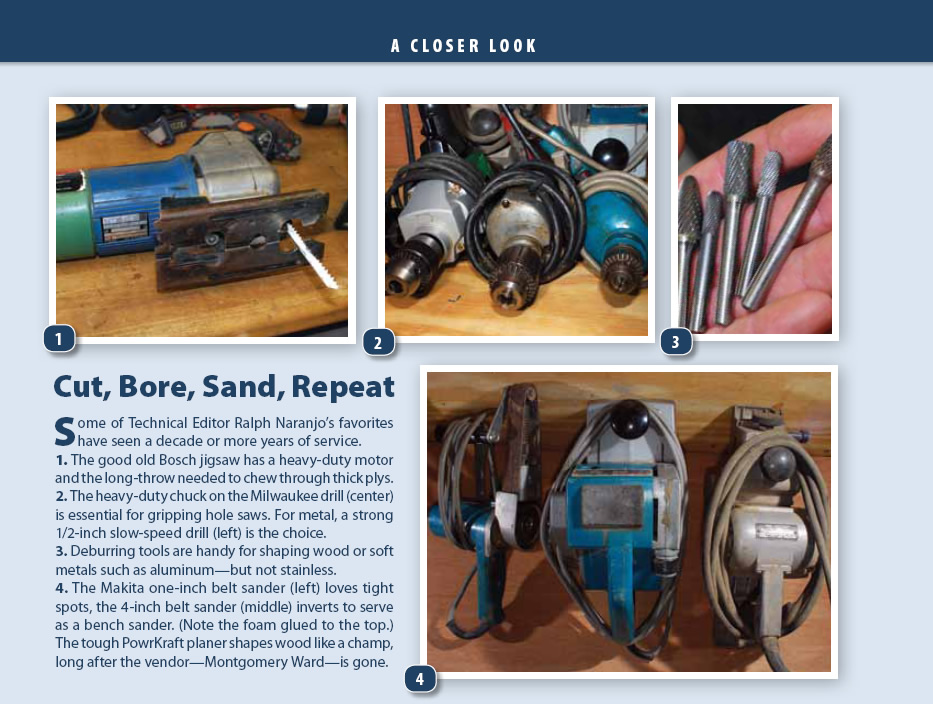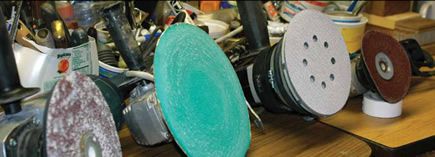
Photos by Ralph Naranjo
375
Every do-it-yourselfer amasses a collection of favorite power tools. Over the decades that I’ve been playing a pro-am role with sailboat projects, I’ve accumulated an interesting cross-section of plug-in and cordless tools. Some have been used to the point where they are nearly worn out, while others gather dust from lack of use. A military-minded person might see a power tool as a force multiplier, but the challenge lies is making sure that your tool strategy is in line with the kind of work that’s in your sights. Tool-collecting and tool-using are two different mindsets, so if you’re out to improve your ability to complete a project, this tool survey should help.
Let’s begin with a brief look back to the days when I ran a full-service boatyard. I had a client who was eager to shoulder the challenge of restoring a classic wooden 50-footer. His plan was to bring down a team of graduates from a traditional boatbuilding school in Maine and have them ply their restoration skills on his half-century-old relic. The Downeaster crew arrived in an old pickup truck brimming with hand saws, block planes, bits and braces, and even a couple of nicely honed adzes. The tools seemed older than the age of the boat and the pickup truck combined—and for a few fascinating weeks, the boatyard looked like a working annex of the Mystic Seaport marine museum.

265
About a month into the project, the toiling artisans fell prey to heresy when a table saw, power plane, belt sander, and 9-inch disc grinder appeared on the job site. Next came a growing profusion of green-boxed Makita cordless tools. A big, red air compressor was their next big score. And as the testament to modernity grew more serious, it became clear that tradition had taken a hit. By the end of the second month, the boat showed some real signs of progress, and the old truck had a new box of tools. The lads from Maine had seen the city lights, but there was also some valuable cross pollination. The dexterity they had developed with sharp chisels and thin-bladed back saws had proven to be transferable, and even though much of the brute cut-and-shape force now came with a whirring power tool, the skill of the craftsman prevailed. In a world where time is money, the transition made sense. And for the very same reasons, picking the right tool for the job is equally as important to those facing their own DIY projects.
Tools of the trade
Giving up hand tools to speed up the process of cutting, shaping or smoothing pays off, especially when the result is also a more accurate edge or a smoother surface. But determining whether or not the cost of a specific tool is worth the investment usually boils down to how often it will be used. In this profile of power tools it’s assumed that the user is not “in the business,” but instead has a dual purpose in buying power tools, and it is a combination of boat and house projects that justify the expenditure.
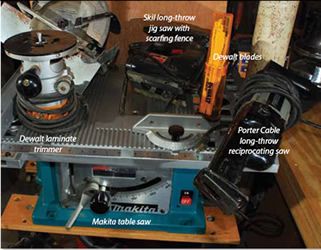
321
Cutting (Saws and Trimmers)
The table saw is the centerpiece of every boatyard’s carpentry shop, and those striking out on their own major refit quickly start looking for a viable alternative. When I switched careers and no longer had a boatyard in the backyard, I went through some serious project withdrawal symptoms. No longer were there a full-sized table saw, band saw, planer/joiner, drill press, and bench sander waiting in harness. To fill the void, I bought a mini-table saw, 4-inch belt sander, and a handheld electric planer. These were added to a collection of drills, sanders, and saber saws. The good news about plug-in tools is that each time you pull the trigger or flip the switch the result is full power at your finger tips. Cordless tools have gone through a battery revolution, and the torque delivered by the latest higher-voltage DC drills, saws, and other tools is impressive. But full power is only available for a relatively short time after you turn on the tool. Don’t get me wrong, I appreciate and use cordless tools. I simply recognize that in many situations, a cord delivering a steady stream of electrons is a useful alternative.
The mini-table saw and belt-sander combo is a junior-varsity substitute for the real deal, but at 20 percent of the cost of their full-sized cousins, they can deliver 60 to 70 percent of the value, especially on boats where lumber lengths are shorter. More often than not, it’s the short-length straight cuts that matter most. Yes, cutting full-length planks is not what you want to be doing on a small 10-inch blade diameter mini-table saw, but it’s impressive to see how much other cutting these little powerhouses can tackle.
The two golden rules are fasten or clamp the saw to a counter or bench before using, and make sure the carbide-tipped blade is sharp and square with the table (or appropriately angled).
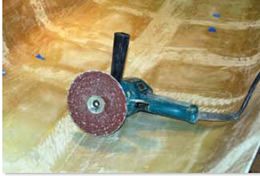
260
Shaping (planers, routers, grinders, and belt sanders)
Wood, fiberglass (FRP), and aluminum can be shaped using many of the same power tools. But as with emergency medical care, there’s always a “do no further harm” caveat. When grinding or heavy sanding, decreasing the numerical grit number of an abrasive disc and increasing the RPM of the sander grinder can be a formula for finishing the work sooner—or doing enough damage to double or triple the scope of a repair. Nowhere does the old adage “the right tool for the job” hold as much sway as with power sanders, or similar tools used to remove material through abrasion. A 4,000-rpm, 15-amp, 120-volt AC grinder can put divots in mild steel plate and whiz through an FRP laminate like it was layers of potato chips. Unless you own a steel boat and have a lot of rust removal work, this type of grinder overkill should be avoided. Lower power, lighter weight sanders in both 9-inch and 5- to 6-inch sizes normally offer more than enough abrasive prowess. It’s important to note that these tools are primarily used for shaping, not sanding, at least when they are used with a stiff pad and a sanding disc held by a center mandrill. Some rotary sander/grinders also allow a soft adhesive or hook-and-eye pad to be attached, allowing the tool to also be used as a more controllable surface-sander. Care must be taken to keep the thick, spongy pad parallel to the surface, and one of the pro’s tricks of the trade to start moving the sanders over the surface before pulling the trigger. If the soft pad is used on a unit that runs with too high an rpm, the adhesive disks can be thrown off like a Frisbee, capable of causing some serious harm.
Boring and fastening (drills and power drivers)
Drilling holes can be as easy as putting a drill bit on a pencil dot and pulling the trigger. Estimating the angle for boring may be fine for some jobs, but others need holes drilled perpendicular to the surface on two planes. When a drill press cannot be used for such a job, a portable guide assembly can be the answer.
Portable cordless drivers and drills have sped up the fastening process, but care must be taken not to over torque a wood or machine screw. Most drill/drivers have an adjustable clutch that can be set to slip at a specified torque load. Picking the right load point is important, and the outcome should tension a wood screw so it reaches the bottom of the plug hole, binds slightly, but does not over-torque and mash the fastener into the wood, or twist it to the breaking point.
Drill motors and the chucks at their business ends range from flimsy to elegant, and the right tool for the job probably lies between the two benchmarks. I still use plug-in drills at the work bench and favor a variable-speed, lightweight Makita 3/8-inch drill for general purpose drilling.
A 3/8-inch Milwaukee with a big chuck and more torque is my choice for drilling metals or running a hole saw. The low-end of the variable-speed range is easy to control, and the drill is not prone to overheating.
For really tough jobs and bits up to half-inch, I have a Hitachi drill with a double-handed grip that runs at very low rpm. It’s a great drill for stainless steel and other tough metal boring. High-quality, carbide-tip bits and cutting oil make the job easier. Using a dull bit on stainless-steel work hardens the metal, making it even more difficult to start the boring process.
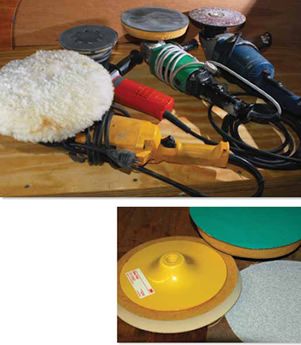
301
Sanding (orbital, rotary, and vibrator)
The obvious, but often not thoroughly considered, goal of sanding is to produce both a fair and a smooth surface. The term “fair” means either perfectly flat or a curve free of unintended dips and rises. Smoothness is easier to attain and simply refers to the texture of the surface.
The big challenge, however, is that most handheld power sanders that fit into categories like vibrator, orbital, or rotary soft pad, do a much better job smoothing the surface than fairing the area. For this reason, most craftsmen first shape the contour, using a long board or a pneumatic-air file-type sander to create a fair surface, and then deal with the final-finish sanding. It’s important to avoid creating dips and divots in a fair surface while attempting to smooth the area before painting.
Tools like the Fein orbital vacuum sander are favorites among the pros as well as amateurs, and its pad is meant to run flat on a surface, making it less prone to creating disc-edge scalloping. Many painters prefer to final sand with a pneumatic soft-pad, dual-action sander known as a “DA sander.” These sanders are lighter because there is no need for the copper windings and a heavy armature required in electric power tools. However, the high volume of compressed air needed to run such equipment is often more than can be supplied by a small, or midsize portable air compressor.
Picks of the Pros
Patrick Tewes of Marine Electric Systems in Severna Park, Md., specializes in custom electrical system installations. He’s an American Boat and Yacht Council-certified electronics technician, but he’s quick to add that his job is as much about woodwork, FRP modification, and metal bracket fabrication as it is about understanding electrical current flow. He drills, hole saws, and cuts through hull skins, bulkheads, and joinery, coping with tight confines and finely crafted woodwork. His tool arsenal is housed in a box truck. It’s a shop on wheels that goes with him from job to job.
In order to get another perspective on tools of the trade, I asked Patrick to pick his six favorites and give me some detail on why each choice was made. His line up when I arrived at a recent job site included one tool with a power cord and five cordless keepers. Here’s his slant on the picks of a pro, and a vantage point we very much endorse.
Fein Multimaster
At the top of his preferred list is a Fein Multimaster, a plug-in, variable-speed, right-angle oscillating tool that accepts a carbide-tipped saw blade, a wide array of triangular shaped sanding pads, and a host of other cutting, scraping, and filing gizmos. The lock-and-load quick attachment process and the “long throw” of the oscillation cycle make this tool more than a noisemaker. It cuts quickly, and the easy-to-mount, hook-and-eye foam sanding pads make sanding in tight corners faster and easier than ever. When it comes to cutting out a small rectangular slot in a bulkhead or sanding woodwork in a tight corner, this is the tool to tackle the job.
The speed of oscillation of this 2.4-pound super tool ranges from 11,000 to 21,000 rpm. It draws about 250 watts of AC current, and the cutting tool options even include a $76 diamond saw blade. The price of the basic kit is $269.
Rigid driver/drill
The Rigid 3/8-inch driver/drill is Patrick’s pick of the litter when it comes to a power tool that’s “always in his carry bag.” The little Rigid drill/driver may not rank as a professional, heavy-duty cordless drill, but its lightweight compact versatility is a big plus. It sports a hand-operable chuck, two rpm ranges, and with a lithium power pack that recharges in 30 minutes, the driver/drill is a fraction of the weight of his heavy-duty Dewalt pro line of power tools. The unit comes as a kit with an LED flashlight, two Lithium-ion batteries and a charger with a discount price of around $150. A lifetime warranty including battery replacement makes this an appealing tool.
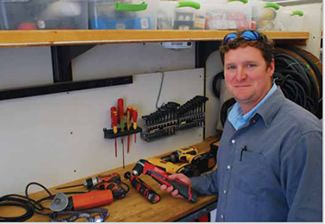
325
Milwaukee M12 right-angle drill/driver kit
Boring holes in hard to reach spaces often requires a right-angle drill, and this compact Milwaukee cordless tool fits the bill. It has a 3/8-inch chuck, and with an rpm range of 0-800 and 100 inch-pounds of torque, it easily drills through fiberglass laminates and wood. The unit’s compact size, light weight, Li-ion battery, and modest price make it appealing to pros and amateurs alike. It sells for around $110 on the Internet.
Milwaukee M12 rotary tool
When it comes to cutting off a fastener in a hard-to-reach location, this slim 9.5-inch-long rotary cutter can get the job done in a hurry. It’s 5,000- to 32,000-rpm range affords excellent control of the cutting tool held in the 1/8-inch collet, and the built-in LED light puts its beam right where the cutting action is taking place. The unit, with battery, weighs only 1.3 pounds, and though its not needed as much as a drill-driver, the tool earns its keep more often than one might expect. Its 30-minute charge time and $100 price tag make it a fast riser on most DIYers wish lists.
Dewalt 18-volt right-angle driver drill
If the Milwaukee right-angle drill mentioned above were considered an elegant hatchet, this hefty 18-volt, right-angle Dewalt driver-drill can be labeled the big axe. There are plenty of times when a big axe or a high-torque drill is just the right tool. It might be when it comes to pushing a 3-inch or larger hole saw through a bulkhead, or putting a 3/8-inch hole in a piece of stainless steel in very tight spot.
When it’s a tough job, Dewalt is up to the task and the fact that the user needs to cope with the tool’s larger size and dumbbell-like weight doesn’t matter. This model sports an 18-volt DC nickel-cadmium (NiCad) battery, and although more power-per-weight is available from lighter Lithium-ion technology, there have been some concerns over higher failure rates among the latter. This jobsite-proven, heavy-duty Dewalt right-angle drill sells for around $200.
Dewalt compact cordless driver
This NiCad-powered drill/driver has a beefy chuck, and it’s a favorite among the pros. The unit has a smooth, user-friendly, variable-speed controller, and enough torque to earn the larger chuck size. Weighing just 4.8 pounds and having relatively compact dimensions, it’s the “diminutive” powerhouse in the Dewalt line up. The company favors a rugged, reliable, high-torque approach to cordless tools, and this slight deviation toward a smaller version of their standard fare is just right for boaters who are often constrained by access space. Dewalt also markets Li-ion tools, but has yet to abandon its tried-and-proven NiCad line. The drill sells for around $170.
Conclusion
You can visit your local hardware store, big box retailer, or consult a tool catalog online. I still have a habit of swinging by Sears to see if they have something Lowe’s or Home Depot has missed. But just as important is noting what the pros use in your boatyard,;and getting their slant on a specific tool can be helpful. Don’t overbuy, there’s no need to have the same exact gear favored by those using the equipment on a day in and day out basis. Gear up for the mainstream of your work needs. A good quality cordless drill/driver, jig saw, circular saw, rotary/orbital sander, and multi-tool may cover most of the bases. Hold off on the laminate trimmer, power plane and portable table saw. As the scope of your projects grows, so will the justification for more specific power tools.
Ralph Naranjo is Practical Sailor’s technical editor and an unabashed admirer and collector of well-made tools.
